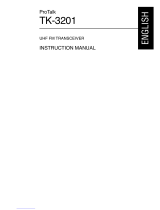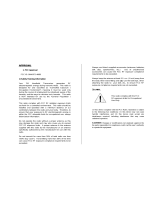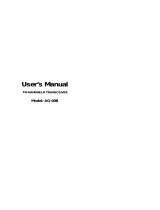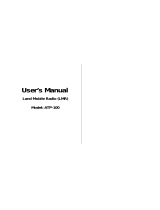Page is loading ...

© B62-1809-10 (K)
09 08 07 06 05 04 03 02 01
TK-2170/ TK-3170/ TK-3173
VHF FM TRANSCEIVER/
UHF FM TRANSCEIVER/
UHF FM TRANSCEIVER
INSTRUCTION MANUAL
ÉMETTEUR-RÉCEPTEUR FM VHF/
ÉMETTEUR-RÉCEPTEUR FM UHF/
ÉMETTEUR-RÉCEPTEUR FM UHF
MODE D’EMPLOI
TRANSCEPTOR DE FM VHF/
TRANSCEPTOR DE FM UHF/
TRANSCEPTOR DE FM UHF
MANUAL DE INSTRUCCIONES

VHF FM TRANSCEIVER/
UHF FM TRANSCEIVER/
UHF FM TRANSCEIVER
TK-2170/ TK-3170/ TK-3173
INSTRUCTION MANUAL
ENGLISH

THANK YOU
We are grateful you have chosen KENWOOD for your land
mobile radio applications. We believe this easy-to-use
transceiver will provide dependable communications to keep
personnel operating at peak efficiency.
KENWOOD transceivers incorporate the latest in advanced
technology. As a result, we feel strongly that you will be
pleased with the quality and features of this product.
MODELS COVERED BY THIS MANUAL
• TK-2170: VHF FM Transceiver
• TK-3170: UHF FM Transceiver
• TK-3173: UHF FM Transceiver
NOTICES TO THE USER
◆ Government law prohibits the operation of unlicensed radio
transmitters within the territories under government control.
◆ Illegal operation is punishable by fine and/or imprisonment.
◆ Refer service to qualified technicians only.
SAFETY: It is important that the operator is aware of and
understands hazards common to the operation of any
transceiver.

i
One or more of the following statements may be
applicable:
FCC WARNING
This equipment generates or uses radio frequency energy. Changes
or modifications to this equipment may cause harmful interference
unless the modifications are expressly approved in the instruction
manual. The user could lose the authority to operate this equipment
if an unauthorized change or modification is made.
INFORMATION TO THE DIGITAL DEVICE USER REQUIRED BY
THE FCC
This equipment has been tested and found to comply with the limits
for a Class B digital device, pursuant to Part 15 of the FCC Rules.
These limits are designed to provide reasonable protection against
harmful interference in a residential installation.
This equipment generates, uses and can generate radio frequency
energy and, if not installed and used in accordance with the
instructions, may cause harmful interference to radio communications.
However, there is no guarantee that the interference will not occur in a
particular installation. If this equipment does cause harmful
interference to radio or television reception, which can be determined
by turning the equipment off and on, the user is encouraged to try to
correct the interference by one or more of the following measures:
• Reorient or relocate the receiving antenna.
• Increase the separation between the equipment and receiver.
• Connect the equipment to an outlet on a circuit different from that
to which the receiver is connected.
• Consult the dealer for technical assistance.

ii
The RBRC Recycle seal found on KENWOOD
nickel-cadmium (Ni-Cd) battery packs indicates
KENWOOD’s voluntary participation in an industry
program to collect and recycle Ni-Cd batteries after
their operating life has expired. The RBRC
program is an alternative to disposing Ni-Cd
batteries with your regular refuse or in municipal
waste streams, which is illegal in some areas.
For information on Ni-Cd battery recycling in your area, call (toll free)
1-800-8-BATTERY (1-800-822-8837).
KENWOOD’s involvement in this program is part of our commitment
to preserve our environment and conserve our natural resources.
Attention (U.S.A. Only):
The RBRC Recycle seal found on KENWOOD
nickel metal hydride (Ni-MH) battery packs
indicates KENWOOD’s voluntary participation in an
industry program to collect and recycle Ni-MH
batteries after their operating life has expired. The
RBRC program is an alternative to disposing Ni-MH
batteries with your regular refuse or in municipal
waste streams, which is illegal in some areas.
For information on Ni-MH battery recycling in your area, call (toll free)
1-800-8-BATTERY (1-800-822-8837).
KENWOOD’s involvement in this program is part of our commitment
to preserve our environment and conserve our natural resources.
The RBRC Recycle seal found on KENWOOD
lithium-ion (Li-ion) battery packs indicates
KENWOOD’s voluntary participation in an industry
program to collect and recycle Li-ion batteries after
their operating life has expired. The RBRC
program is an alternative to disposing Li-ion
batteries with your regular refuse or in municipal
waste streams, which is illegal in some areas.
For information on Li-ion battery recycling in your area, call (toll free)
1-800-8-BATTERY (1-800-822-8837).
KENWOOD’s involvement in this program is part of our commitment
to preserve our environment and conserve our natural resources.

iii
PRECAUTIONS
• Do not charge the transceiver and battery pack when they are
wet.
• Ensure that there are no metallic items located between the
transceiver and the battery pack.
• Do not use options not specified by KENWOOD.
• If the die-cast chassis or other transceiver part is damaged, do
not touch the damaged parts.
• If a headset or headphone is connected to the transceiver, reduce
the transceiver volume. Pay attention to the volume level when
turning the squelch off.
• Do not place the microphone cable around your neck while near
machinery that may catch the cable.
• Do not place the transceiver on unstable surfaces.
• Ensure that the end of the antenna does not touch your eyes.
• When the transceiver is used for transmission for many hours, the
radiator and chassis will become hot. Do not touch these
locations when replacing the battery pack.
• Do not immerse the transceiver in water.
• Always switch the transceiver power off before installing optional
accessories.

iv
Turn the transceiver power off in the following locations:
• In explosive atmospheres (inflammable gas, dust particles,
metallic powders, grain powders, etc.).
• While taking on fuel or while parked at gasoline service stations.
• Near explosives or blasting sites.
• In aircrafts.
• In medical institutions or near persons using pacemakers.
• Do not disassemble or modify the transceiver for any reason.
• Do not place the transceiver on or near airbag equipment while
the vehicle is running. When the airbag inflates, the transceiver
may be ejected and strike the driver or passengers.
• Do not transmit while touching the antenna terminal or if any
metallic parts are exposed from the antenna covering.
Transmitting at such a time may result in a high-frequency burn.
• If an abnormal odor or smoke is detected coming from the
transceiver, switch the transceiver power off immediately, remove
the battery pack from the transceiver, and contact your
KENWOOD dealer.
• Use of the transceiver while you are driving may be against traffic
laws. Please check and observe the vehicle regulations in your
area.
• Do not expose the transceiver to extremely hot or cold
conditions.
• Do not carry the battery pack (or battery case) with metal objects,
as they may short the battery terminals.
• When operating the transceiver in areas where the air is dry, it is
easy to build up an electric charge (static electricity). When using
a earphone accessory in such conditions, it is possible for the
transceiver to send an electric shock through the earphone and
to your ear. We recommend you use only a speaker/microphone
in these conditions, to avoid electric shocks.

v
CONTENTS
UNPACKING AND CHECKING EQUIPMENT ............................. 1
S
UPPLIED ACCESSORIES ....................................................... 1
PREPARATION .............................................................. 2
B
ATTERY PACK PRECAUTIONS .................................................. 2
I
NSTALLING/ REMOVING THE (OPTIONAL) BATTERY PACK ......................... 7
I
NSTALLING/ REMOVING ALKALINE BATTERIES .................................... 8
I
NSTALLING THE (OPTIONAL) ANTENNA .......................................... 9
I
NSTALLING THE BELT CLIP .................................................... 9
I
NSTALLING THE CAP OVER THE SPEAKER/ MICROPHONE JACKS ................... 10
I
NSTALLING THE (OPTIONAL) SPEAKER/ MICROPHONE .......................... 10
GETTING ACQUAINTED .................................................. 11
D
ISPLAY ................................................................... 13
PROGRAMMABLE FUNCTIONS ......................................... 15
OPERATING BASICS ..................................................... 16
O
VERVIEW ................................................................. 16
S
WITCHING POWER ON/ OFF ............................................... 16
A
DJUSTING THE VOLUME .................................................... 17
S
ELECTING A ZONE AND CHANNEL/ GROUP ID ................................ 17
TRUNKING ZONES (TK-3173 ONLY) ................................... 18
P
LACING A DISPATCH CALL .................................................. 18
R
ECEIVING A DISPATCH CALL ................................................ 18
P
LACING A TELEPHONE CALL ................................................. 19
R
ECEIVING A TELEPHONE CALL ............................................... 19
CONVENTIONAL ZONES ................................................. 20
T
RANSMITTING .............................................................. 20
R
ECEIVING ................................................................. 20
Q
UIET TALK (QT)/ DIGITAL QUIET TALK (DQT) .............................. 20
2-
TONE SIGNALING .......................................................... 21
O
PERATOR SELECTABLE TONE (OST) ........................................ 22
V
OICE OPERATED TRANSMISSION (VOX) ..................................... 22

vi
SCAN ....................................................................... 24
A
DD TO SCAN/ DELETE FROM SCAN .......................................... 25
P
RIORITY SCAN ............................................................. 25
G
ROUP SCAN (TK-3173 ONLY) ............................................ 25
S
CAN REVERT .............................................................. 26
FleetSync: ALPHANUMERIC 2-WAY PAGING FUNCTION ................... 27
S
ELCALL (SELECTIVE CALLING) .............................................. 27
S
TATUS MESSAGE .......................................................... 28
S
HORT MESSAGES .......................................................... 30
L
ONG MESSAGES ........................................................... 30
DTMF (DUAL TONE MULTI FREQUENCY) CALLS .................... 31
M
ANUAL DIALING (KEYPAD MODELS ONLY) .................................. 31
S
TORE AND SEND ........................................................... 32
A
UTODIAL .................................................................. 32
R
EDIAL (KEYPAD MODELS ONLY) ............................................ 34
C
ONNECT/ DISCONNECT IDS (KEYPAD MODELS ONLY) ......................... 35
DTMF S
IGNALING ......................................................... 35
S
TUN ...................................................................... 35
EMERGENCY CALLS ..................................................... 36
ADVANCED OPERATIONS ............................................... 37
S
ELECTING A TRANSMIT POWER .............................................. 37
T
ALK AROUND .............................................................. 37
M
ONITOR/ SQUELCH OFF .................................................... 38
S
CRAMBLER ................................................................ 39
K
EY LOCK .................................................................. 39
T
RANSCEIVER BACKLIGHT .................................................... 40
BACKGROUND OPERATIONS ........................................... 41
T
IME-OUT TIMER (TOT) .................................................... 41
B
USY CHANNEL LOCKOUT (BCL) ............................................ 41
B
ATTERY SAVER ............................................................ 41
B
ATTERY STATUS INDICATOR ................................................. 42
B
EGINNING/ END OF TRANSMIT SIGNAL ....................................... 42

1
UNPACKING AND CHECKING EQUIPMENT
Note: The following unpacking instructions are for use by your
KENWOOD dealer, an authorized KENWOOD service facility, or the
factory.
Carefully unpack the transceiver. We recommend that you
identify the items listed in the following table before discarding
the packing material. If any items are missing or have been
damaged during shipment, file a claim with the carrier
immediately.
SUPPLIED ACCESSORIES
Belt clip Speaker/ microphone
locking bracket
metI rebmuNtraP ytitnauQ
pilctleBXX-1070-92J1
pacskcajenohporcim/rekaepSXX-6860-90B1
gnikcolenohporcim/rekaepS
tekcarb
XX-3845-91J1
launamnoitcurtsnIXX-9081-26B1
Speaker/ microphone
jacks cap

2
PREPARATION
BATTERY PACK PRECAUTIONS
Do not use battery packs or battery chargers not
recommended by KENWOOD.
◆ Do not recharge the battery pack if it is already fully charged.
Doing so may cause the life of the battery pack to shorten or the
battery pack may be damaged.
◆ After recharging the battery pack, disconnect it from the charger.
If the charger power is reset (turned ON after being turned OFF),
recharging will start again and the battery pack will become
overcharged.
◆ Do not use the transceiver while charging the battery pack. We
recommend you switch the transceiver power OFF while
charging is taking place.
◆ Do not charge the battery pack when the battery pack or
transceiver is wet, to avoid the risk of fire or damage. Wipe the
water from the battery pack or transceiver using a dry cloth
before charging.
◆ Do not short the battery terminals or dispose of the battery by
fire.
◆ Never attempt to remove the casing from the battery pack.
■ CHARGING THE BATTERY PACK
For charging procedures, refer to the battery charger
Instruction Manual.

3
Information concerning the (optional) Li-ion battery pack:
The battery pack includes flammable objects such as organic solvent.
Mishandling may cause the battery to rupture producing flames or
extreme heat, deteriorate, or cause other forms of damage to the battery.
Please observe the following prohibitive matters.
• Do not disassemble or reconstruct battery!
The battery pack has a safety function and protection circuit to
avoid danger. If they suffer serious damage, the battery may
generate heat or smoke, rupture, or burst into flame.
• Do not short-circuit the battery!
Do not join the + and – terminals using any form of metal (such as
a paper clip or wire). Do not carry or store the battery pack in
containers holding metal objects (such as wires, chain-necklace or
hairpins). If the battery pack is short-circuited, excessive current
will flow and the battery may generate heat or smoke, rupture, or
burst into flame. It will also cause metal objects to heat up.
• Do not incinerate or apply heat to the battery!
If the insulator is melted, the gas release vent or safety function is
damaged, or the electrolyte is ignited, the battery may generate
heat or smoke, rupture, or burst into flame.
• Do not use or leave the battery near fires, stoves, or other
heat generators (areas reaching over 80°C/ 176°F)!
If the polymer separator is melted due to high temperature, an
internal short-circuit may occur in the individual cells and the
battery may generate heat or smoke, rupture, or burst into flame.
• Do not immerse the battery in water or get it wet by other
means!
If the battery’s protection circuit is damaged, the battery may
charge at extreme current (or voltage) and an abnormal chemical
reaction may occur. The battery may generate heat or smoke,
rupture, or burst into flame.
• Do not charge the battery near fires or under direct sunlight!
If the battery’s protection circuit is damaged, the battery may
charge at extreme current (or voltage) and an abnormal chemical
reaction may occur. The battery may generate heat or smoke,
rupture, or burst into flame.
DANGER

4
• Use only the specified charger and observe charging
requirements!
If the battery is charged in unspecified conditions (under high
temperature over the regulated value, excessive high voltage or
current over regulated value, or with a remodelled charger), it may
overcharge or an abnormal chemical reaction may occur. The
battery may generate heat or smoke, rupture, or burst into flame.
• Do not pierce the battery with any object, strike it with an
instrument, or step on it!
This may break or deform the battery, causing a short-circuited.
The battery may generate heat or smoke, rupture, or burst into
flame.
• Do not jar or throw the battery!
An impact may cause the battery to leak, generate heat or
smoke, rupture, and/or burst into flame. If the battery’s protection
circuit is damaged, the battery may charge at an abnormal
current (or voltage), and an abnormal chemical reaction may
occur. The battery may generate heat or smoke, rupture, or burst
into flame.
• Do not use the battery pack if it is damaged in any way!
The battery may generate heat or smoke, rupture, or burst into
flame.
• Do not solder directly onto the battery!
If the insulator is melted or the gas release vent or safety function
is damaged, the battery may generate heat or smoke, rupture, or
burst into flame.
• Do not reverse the battery polarity (and terminals)!
When charging a reversed battery, an abnormal chemical
reaction may occur. In some cases, an unexpected large amount
of current may flow upon discharging. The battery may generate
heat or smoke, rupture, or burst into flame.
• Do not reverse-charge or reverse-connect the battery!
The battery pack has positive and negative poles. If the battery
pack does not smoothly connect with a charger or operating
equipment, do not force it; check the polarity of the battery. If the
battery pack is reverse-connected to the charger, it will be
reverse-charged and an abnormal chemical reaction may occur.
The battery may generate heat or smoke, rupture, or burst into
flame.

5
• Do not charge the battery for longer than the specified time!
If the battery pack has not finished charging even after the
regulated time has passed, stop it. The battery may generate
heat or smoke, rupture, or burst into flame.
• Do not place the battery pack into a microwave or high
pressure container!
The battery may generate heat or smoke, rupture, or burst into
flame.
• Keep ruptured and leaking battery packs away from fire!
If the battery pack is leaking (or the battery emits a bad odor),
immediately remove it from flammable areas. Electrolyte leaking
from battery can easily catch on fire and may cause the battery to
generate smoke or burst into flame.
• Do not use an abnormal battery!
If the battery pack emits a bad odor, appears to have different
coloring, is deformed, or seems abnormal for any other reason,
remove it from the charger or operating equipment and do not
use it. The battery may generate heat or smoke, rupture, or burst
into flame.
• Do not touch a ruptured and leaking battery!
If the electrolyte liquid from the battery gets into your eyes, wash
your eyes out with fresh water as soon as possible, without
rubbing your eyes. Go to the hospital immediately. If left
untreated, it may cause eye-problems.

6
■ USING THE LI-ION BATTERY PACK
• Charge the battery pack before using it.
•To keep the battery discharge at a minimum, remove the
battery pack from the equipment when it is not in use. Store
the battery pack in a cool and dry location.
• When storing the battery pack for a long period:
1 Remove the battery pack from the equipment.
2 Discharge the battery pack, if possible.
3 Store the battery pack in a cool (below 25°C/ 77°F) and
dry location.
■ CHARACTERISTICS OF THE LI-ION BATTERY PACK
• As the battery pack is charged and discharged repeatedly, the
battery capacity decreases.
• Even if the battery pack is unused, the battery pack
degrades.
• It takes a longer time to charge the battery pack in cooler
areas.
• The life of battery pack is shortened when it is charged and
discharged in hotter areas. When the battery pack is stored
in a hot location, the battery pack degrades quicker. Do not
leave the battery pack in vehicles or near heating appliances.
• When the battery pack operating time becomes short, even if
it is fully charged, replace the battery pack. Continuing to
charge and discharge the battery pack may result in
electrolyte leakage.

7
INSTALLING/ REMOVING THE (OPTIONAL) BATTERY PACK
1 Align the battery pack with the
back of the transceiver, then
press the battery pack and
transceiver firmly together
until the release latch clicks,
locking it in place.
2 Lock the safety catch into
place to prevent accidentally
pressing the release latch and
removing the battery.
3 To remove the battery pack,
lift the safety catch on the
base of the transceiver, then
press the release latch
underneath the safety catch
while pulling the battery pack
away from the transceiver.
Note:
◆ To lift the battery pack safety catch, use a piece of hardened
plastic or metal, such as a screwdriver, that is no more than 6 mm
wide and 1 mm thick. It is imperative that you place the
implement under only the lip of the safety catch so that you do
not damage the release latch.
◆ Before charging a battery pack that is attached to the transceiver,
ensure that the safety catch is firmly closed.
◆ While operating the transceiver using a Li-ion or Ni-MH battery
pack in areas with an ambient temperature of –10°C/ +14°F and
lower, operating time may be shortened.

8
INSTALLING/ REMOVING ALKALINE BATTERIES
◆ Do not install batteries in a hazardous environment where sparks
could cause an explosion.
◆ Never discard batteries in fire; extremely high temperatures can
cause batteries to explode.
◆ Do not short circuit the battery case terminals.
◆ Do not use rechargeable batteries.
Note:
◆ If you do not plan to use the transceiver for a long period, remove
the batteries from the battery case.
◆ This battery case has been designed for transmitting at a power
of approximately 1 W (the low power setting on your transceiver).
If you want to transmit a stronger signal (using the high power
setting on your transceiver), use an optional rechargeable battery
pack.
1 To open the battery case,
press on the two tabs on the
upper rear of the case, then
pull the two halvs apart.
2 Insert 6 AA (LR6) Alkaline
batteries into the battery case.
• Be sure to match the polarities
with those marked in the
bottom of the battery case.
3 Align the tabs of the cover
with the base, then push down
on the cover until it locks in
place.

9
Screw the antenna into the connector
on the top of the transceiver by
holding the antenna at its base and
turning it clockwise until secure.
Note: The antenna is neither a handle, a
key ring retainer, nor a speaker/
microphone attachment point. Using the
antenna in these ways may damage the
antenna and degrade your transceiver’s
performance.
INSTALLING THE (OPTIONAL) ANTENNA
INSTALLING THE BELT CLIP
Note: When first installing the belt clip,
you must remove the battery pack from
the rear of the transceiver.
1 Remove the 2 screws from the
rear of the transceiver, then
remove the small, plastic black
covering that was held in place.
2 Insert the belt clip mount into the
space on the rear of the
transceiver.
3 Using the 2 screws, affix the belt
clip in place.
Note: Do not dispose of the plastic black
covering! If you remove the belt clip,
replace the covering into the space on
the rear of the transceiver. Either this
covering or the belt clip must be in place,
otherwise the battery pack may not
remain installed properly.

10
INSTALLING THE CAP OVER THE SPEAKER/ MICROPHONE JACKS
Install the cap over the speaker/ microphone jacks when not
using an optional speaker/ microphone.
1 Insert the speaker/ microphone plugs into the
speaker/ microphone jacks of the transceiver.
2 Place the locking bracket over the speaker/
microphone plugs so that the locking tabs
insert into the transceiver grooves.
3 While holding the locking bracket in place,
push it towards the bottom of the transceiver
until the tabs on the bracket click into place.
Note:
◆ When not using an optional speaker/ microphone,
install the cap over the speaker/ microphone jacks.
◆ The transceiver is not fully water resistant when
using a speaker/ microphone or headset.
•To remove the locking bracket, push the bracket up
from the base.
1 Place the cap over the jacks so that the locking
tabs insert into the transceiver grooves.
2 While holding the cap in place, push it towards
the bottom of the transceiver until the tabs on
the cap click into place.
Note: To keep the transceiver water resistant, you must
cover the speaker/ microphone jacks with the supplied cap.
•To remove the cap, hold the top of the cap in place
with your finger while inserting a 3 mm or smaller flat
blade screwdriver under the bottom of the cap.
Slowly slide the screwdriver in until its tip touches the
tab inside the cap, then gently pry the cap up (handle
of screwdriver moving away from the transceiver) to
remove the cap.
INSTALLING THE (OPTIONAL) SPEAKER/ MICROPHONE

11
GETTING ACQUAINTED
* The transceiver is also available without the DTMF keypad (!2).
qq
qq
q Antenna connector
Connect an (optional) antenna here {page 9}.
ww
ww
w Selector
Rotate to activate its programmable function {page 15}.
ee
ee
e Power switch/ Volume control
Turn clockwise to switch ON the transceiver. Rotate to
adjust the volume. Turn counterclockwise fully to switch
OFF the transceiver.
q t
u
i
o
!0
!0
r y
w e
!1
!1
!2
!2
!3
!3
Microphone
Speaker
/




